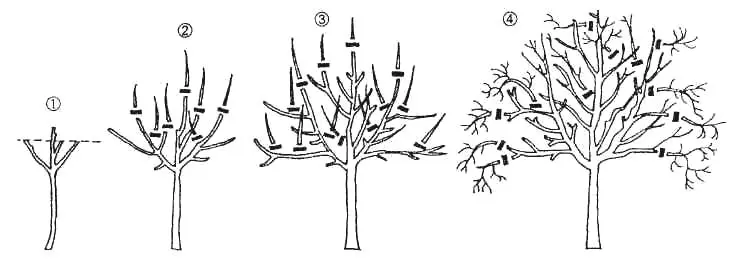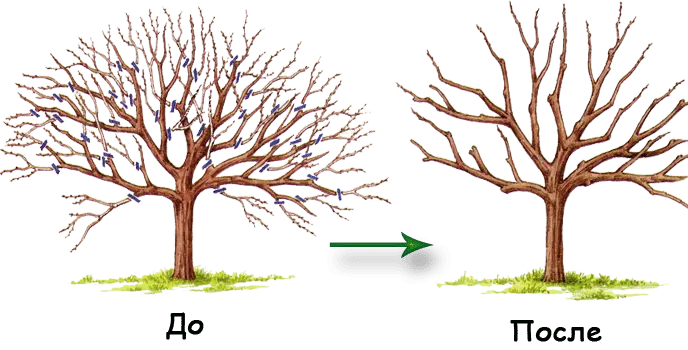Contents
Very often in our gardens you can find such a fruit tree as a pear. However, such an issue as pear pruning is not always given due attention. Some do not see the need for this, and some are afraid to take on this process, for fear of harming the tree. However, not pruning the tree can cause even more damage. This article is intended to highlight all the nuances of pear pruning.
Fundamental rules
Most pear varieties are not prone to overly active growth and the formation of new branches, but crown overgrowth still occurs, albeit not at such a rapid pace. And since this fruit crop is a light-loving species, pruning of pear trees is necessary. The tree is subjected to this procedure, starting from a very young age, and periodically repeated until it dries out.
Proper pruning has a number of valuable benefits:
- creating a strong skeletal base that will be able to withstand the load of massive fruits;
- rational, uniform distribution of nutrients throughout the pear, which will favorably affect the growth of the crop and the development of the tree as a whole;
- sufficient space for access to sunlight;
- sufficient space for effective spraying;
- ease of fruit picking.
Conversely, incorrect, irregular pruning can cause increased growth of branches, which will deplete the tree and adversely affect fruiting.
The basic rules for pear pruning can be reduced to the following points:
- it is necessary to know the methods and types of this procedure in order to carry out the necessary pruning, depending on the goals and situation;
- acquire and prepare the necessary tools for work in advance;
- be knowledgeable in the basic aspects of technology.
Methods and types
Two methods are applicable for pruning pear trees:
- shortening. It involves cutting off the upper parts of the branches and (or) annual growths. This method slows down the growth of the tree upwards, favors horizontal branching, the frequency of fruit formation is somewhat reduced, but their quality is increased.
- thinning. It implies the complete removal of branches and growth branches (“on the ring”, i.e. cutting branches at their very base, near the trunk or mother branch). Thinning gives more access to sunlight inside the crown, which stimulates leaf growth, increases the volume and quality of the crop, increases the ability to protect the pear from pests and diseases. This method does not stimulate the growth of the remaining branches and shoots, but leads to the formation of strong productive fruits (due to the redistribution of nutrients).
These methods are used in combination with additional techniques – tilt, garter, kerbovka, bending shoots and branches, etc.
Also, depending on the purpose of pruning pear trees, there are several types of it:
- formative. The goal is to give the crown the necessary shape, stimulate the fouling of fruit wood. It is involved in the first years of growth of young pears, involves cutting the minimum number of branches in the period preceding the onset of fruiting;
- supporting. The goal is to regulate the number of fruiting branches to maintain nutrient balance and consistent fruit bearing. It is activated on mature trees that have entered the fruiting stage;
- rejuvenating. The goal is to prolong the period of fruiting and life of the tree, the activation or resumption of the processes of formation of high-quality fruits and growth. It is used on old pears and trees that have lived more than half of their life cycle.
Инструментарий
To carry out effective pruning, you must have the appropriate set of tools:
- pruner;
- delimber;
- garden knife;
- saw on wood;
- scissors for gardening;
- garden pitch;
- paint based on natural drying oil (in the absence of pitch).
It should be remembered that all cutting and sawing tools must be properly sharpened. The place of the cut should be even, without crushed and torn fibers. Also, all tools, especially blades, must be clean to avoid the possibility of infection in the tree.
Technique and nuances
The technique of this process can be represented in the following scheme:
- the first pruning for a pear is designed to begin to form its crown;
- at the height of the trunk determined by you, a kidney is selected that grows in the plane of the row (a reference starting point, the so-called “first kidney”);
- the next three buds from the first are removed to allow the conductor to grow freely and to allow the branches to grow at a more suitable angle;
- the fifth kidney from the first is left for the development of the second branch (it is placed on the side of the trunk opposite from the first kidney in the plane of the row);
- from the sixth to the eighth kidney is removed;
- above the ninth bud, a cut of an annual shoot is made;
- upon reaching a pear of two years of age, the central conductor of the tree should prevail over the rest of the branches by at least 0,2 m (if necessary, individual branches are shortened for this);
- skeletal branches are formed by shortening, tilting, bending;
- upon reaching the pear of four to five years of age, the central conductor is shortened to the base of the first (uppermost) skeletal branch;
- in the future, the center of the crown is maintained in an open state, preventing it from thickening;
- all shoots growing from the trunk at an acute angle or going to the center of the crown are removed;
- not fruitful (top) branches and branches that grow parallel to the trunk are cut;
- shorten young growth by one third;
- fruits, if possible, are not cut off.

Annual pear pruning scheme
All stages of this process will be clearly visible in the video below.
There are also some nuances:
- if the pruning area is very large, then it is better to stretch it for several seasons;
- in addition to direct pruning with tools, you can use a self-cutting mechanism – the branch is pulled with a flexible, not thin wire, and thanks to growing wood, the constriction will cut the branch itself in a couple of years;
- when using a pruner, it should be turned with a thin blade towards the shoot being cut;
- for quick healing, the branch must be cut “on the ring”, without stumps, but also without deep cuts;
- prevent the bark from being lifted at the cut points (for this, the branch is first cut from below, and only then from above);
- a large branch must be removed in parts;
- slices are smeared with pitch or natural paint;
- after medium or heavy pruning, the tree does not need additional feeding. it has plenty of free nutrients.
It is important not to forget: do not cut the pear too much in one go, this will not only be a great stress for the tree, but will also provoke intensive growth of tops.
Video “Correct formation of the pear crown”
Below is a video of the formation of a pear crown, where you can consider in detail all the processes.
Deadlines
Pear pruning is carried out at different times, pursuing different goals and objectives. You just need to know the features of each season.
Spring pruning
In the spring, one of the most important parts of the work is done. Mostly during this period, weakly fruiting branches growing inside the crown of the branch are removed (as was seen in the video above).
Already one-year-old trees, the top is shortened to avoid future darkening of the crown and to stimulate the growth of the lower branches from which the crown will form.
Next spring, in a similar way, it is necessary to form the second tier of the crown skeleton. The central conductor is cut off one quarter of its length, and the rest – completely. Lateral skeletal shoots (maximum – 4) are left to grow at a slope of 45 degrees. Branches with ovaries are directed to grow in a horizontal position. A year later, the procedure is repeated.
So that the tree does not suffer, it is important to remember the following:
- all manipulations must be carried out before the start of sap flow;
- the temperature is stable above -6-7 degrees Celsius;
- check the weather forecast for the near future to rule out frost.
Autumn pruning
Pear pruning in autumn is carried out every year, with the exception of the year of planting.
The time of the procedures depends on the varietal characteristics of the tree and on the climatic zone of growth. When pruning pears in autumn, it is very important to exclude the possibility of early frosts. cut points are more prone to freezing, which can greatly damage the tree. Therefore, the optimal time is early autumn.
Autumn is the time to remove damaged, diseased, extra branches, which are then burned. Annual shoots are shortened by one third of the length. When pruning a pear in autumn, care must be taken to ensure that the young shoots continue the given crown shape.

Pear before and after pruning
Winter pruning
In winter, it is best to do shaping pruning. during this period, the directions of growth of all branches are very clearly visible. Damaged and frozen branches are also cut off. This fruit crop has a sufficient level of frost resistance, so manipulations with it can begin when the temperature stops dropping below -15.
In winter, the tree is at rest, all processes are as slow as possible, so all the cuts caused will bring him almost no noticeable damage. However, heavy pruning is still not recommended.
Summer pruning
Pruning in the summer involves minimal intervention. It is carried out only in the presence of a large number of actively growing shoots. It is allowed to trim diseased, broken shoots, as well as branches that can break off under their own weight.
Features of age pruning (young and old trees)
In addition to seasonal, there are also age aspects in pruning pear trees.
young pears
For procedures with young trees, the following features are characteristic:
- the first pruning – after planting in a permanent place of growth to facilitate adaptation and lay the foundation for the shape of the crown;
- in the first autumn, no cuts are made;
- trees from a year and older are pruned twice a year to increase branching, the formation of a crown skeleton and the growth of fruit branches;
- annual increments are cut by a quarter;
- the second tier of branches is laid when the tree reaches 4 years;
- do not subject a young tree to strong shortening. because of this, the pear will begin to bear fruit later.
old pears
Features of pruning old fruit trees:
- the optimal time for work is spring or autumn;
- shoots are shortened by half or two-thirds of the length, which will help rejuvenate and slow down aging;
- at the time of anti-aging procedures, the volume of fruiting will decrease.
Knowing all the nuances of this process, you will be able to organize a plan for the most rational pruning with the maximum positive effect.









